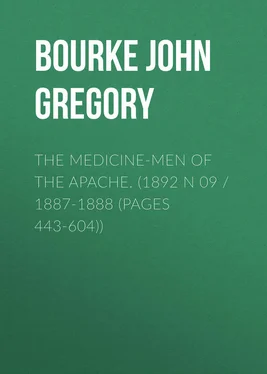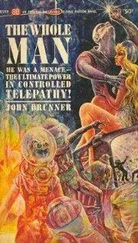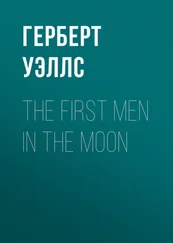John Bourke - The Medicine-Men of the Apache. (1892 N 09 / 1887-1888 (pages 443-604))
Здесь есть возможность читать онлайн «John Bourke - The Medicine-Men of the Apache. (1892 N 09 / 1887-1888 (pages 443-604))» — ознакомительный отрывок электронной книги совершенно бесплатно, а после прочтения отрывка купить полную версию. В некоторых случаях можно слушать аудио, скачать через торрент в формате fb2 и присутствует краткое содержание. Жанр: foreign_antique, foreign_prose, на английском языке. Описание произведения, (предисловие) а так же отзывы посетителей доступны на портале библиотеки ЛибКат.
- Название:The Medicine-Men of the Apache. (1892 N 09 / 1887-1888 (pages 443-604))
- Автор:
- Жанр:
- Год:неизвестен
- ISBN:нет данных
- Рейтинг книги:4 / 5. Голосов: 1
-
Избранное:Добавить в избранное
- Отзывы:
-
Ваша оценка:
- 80
- 1
- 2
- 3
- 4
- 5
The Medicine-Men of the Apache. (1892 N 09 / 1887-1888 (pages 443-604)): краткое содержание, описание и аннотация
Предлагаем к чтению аннотацию, описание, краткое содержание или предисловие (зависит от того, что написал сам автор книги «The Medicine-Men of the Apache. (1892 N 09 / 1887-1888 (pages 443-604))»). Если вы не нашли необходимую информацию о книге — напишите в комментариях, мы постараемся отыскать её.
The Medicine-Men of the Apache. (1892 N 09 / 1887-1888 (pages 443-604)) — читать онлайн ознакомительный отрывок
Ниже представлен текст книги, разбитый по страницам. Система сохранения места последней прочитанной страницы, позволяет с удобством читать онлайн бесплатно книгу «The Medicine-Men of the Apache. (1892 N 09 / 1887-1888 (pages 443-604))», без необходимости каждый раз заново искать на чём Вы остановились. Поставьте закладку, и сможете в любой момент перейти на страницу, на которой закончили чтение.
Интервал:
Закладка:
Of the Peruvians we are informed that "their belief was that there was a man in the sky with a sling and a stick, and that in his power were the rain, the hail, the thunder, and all else that appertains to the regions of the air, where clouds are formed." 122 122 Clements R. Markham, Note on Garcilasso de la Vega, in Hakluyt Soc., vol. 41, p. 183, quoting Acosta, lib. 5, cap. 4.
The sacred twirler of the snake dance is found in Greece, America, Africa and New Zealand. It survives as a toy in England and the United States. 123 123 Andrew Lang, Custom and Myth, New York, 1885, chapter entitled "The bull roarer," pp. 29-44.
The same peculiar instrument has been noticed in the religious ceremonials of the Australians, especially in the initiatory rites of the "bora." It is called the "tirricoty." 124 124 John Fraser, The Aborigines of Australia; their Ethnic Position and Relations, pp. 161-162.
The twirling of the tzi-ditindi in medicine or prayer corresponds to the revolution of the prayer wheel of the Lamas.
THE CROSS
The sign of the cross appears in many places in Apache symbolism. The general subject of the connection of the cross with the religion of the aborigines of the American continent has been so fully traversed by previous authors that I do not care to add much more to the subject beyond saying that my own observation has assured me that it is related to the cardinal points and the four winds, and is painted by warriors upon their moccasins upon going into a strange district in the hope of keeping them from getting on a wrong trail.
In October, 1884, I saw a procession of Apache men and women, led by the medicine-men bearing two crosses, made as follows: The vertical arm was 4 feet 10 inches long, and the transverse between 10 and 12 inches, and each was made of slats about 1½ inches wide, which looked as if they had been long in use. They were decorated with blue polka dots upon the unpainted surface. A blue snake meandered down the longer arm. There was a circle of small willow twigs at top; next below that, a small zinc-cased mirror, a bell, and eagle feathers. Nosey, the Apache whom I induced to bring it to me after the ceremony, said that they carried it in honor of Guzanutli to induce her to send rain, at that time much needed for their crops. It is quite likely that this particular case represents a composite idea; that the original beliefs of the Apache have been modified to some extent by the crude ideas of the Mexican captives among them, who still remember much that was taught them in the churches of the hamlets in northern Mexico, from which they were kidnapped years ago; but, on the other hand, it is to be remembered that the cross has always formed a part of the Apache symbolism; that the snake does not belong to the Christian faith, and that it has never been allowed to appear upon the cross since the time of the Gnostics in the second and third centuries. Therefore, we must regard that as a Pagan symbol, and so must we regard the circle of willow twigs, which is exactly the same as the circle we have seen attached to the sacred cords for the cure of headache. 125 125 "When the rain-maker of the Lenni Lennape would exert his power, he retired to some secluded spot and drew upon the earth the figure of a cross (its arms toward the cardinal points?), placed upon it a piece of tobacco, a gourd, a bit of some red stuff, and commenced to cry aloud to the spirits of the rains." – Brinton, Myths of the New World, New York, 1868, p. 96 (after Loskiel).
The cross was found in full vogue as a religious emblem among the aborigines all over America. Father Le Clercq 126 126 Père Chrestien Le Clercq, Gaspesie, Paris, 1691, p. 170.
speaks of its very general employment by the Gaspesians: "Ils ont parmi eux, tout infideles qu'ils soient, la Croix en singuliere veneration, qu'ils la portent figurée sur leurs habits & sur leur chair; qu'ils la tiennent à la main dans tous leurs voïages, soit par mer, soit par terre; & qu'enfin ils la posent au dehors & au dedans de leurs Cabannes, comme la marque d'honneur qui les distingue des autres Nations du Canada." He narrates 127 127 Ibid., cap. x, pp. 172-199.
that the Gaspé tradition or myth was, that the whole tribe being ravaged by a plague, the medicine-men had recourse to the Sun, who ordered them to make use of the cross in every extremity.
Herrera relates that the followers of Hernandez de Cordoba found at Cape Catoche "unos Adoratorios … i Cruces pintadas que les causò gran admiracion." 128 128 Dec. 2, lib. 2, p. 48.
He also says that Juan de Grijalva on the island of Cozumel found a number of oratories and temples, but one in particular was made in the form of a square tower, with four openings. Inside this tower was a cross made of lime, which the natives reverenced as the god of the rain; "una Cruz de Cal, de tres varas en alto, à la qual tenian por el Dios de la lluvia." 129 129 Ibid., p. 59.
NECKLACES OF HUMAN FINGERS
The necklace of human fingers, an illustration of which accompanies this text (Pl. IV), belonged to the foremost of the medicine-men of a brave tribe – the Cheyenne of Montana and Wyoming. They were the backbone of the hostility to the whites, and during the long and arduous campaign conducted against them by the late Maj. Gen. George Crook, which terminated so successfully in the surrender of 4,500 of the allied Sioux and Cheyenne, at Red Cloud and Spotted Tail agencies, in the early spring of 1877, it was a noted fact that wherever a band of the Cheyenne was to be found there the fighting was most desperate. It is a matter now well established that the Cheyenne are an offshoot of the Algonquian family, speaking a dialect closely resembling that of the Cree, of British America.
It may interest some readers to listen to a few words descriptive of the manner in which such a ghastly relic of savagery came into my possession. On the morning of the 25th of November, 1876, the cavalry and Indian scouts (Sioux, Shoshoni, Arapaho, Pawnee, and a few of the Cheyenne themselves), of Gen. Crook's command, under the leadership of the late Brig. Gen. Ranald S. Mackenzie, then colonel of the Fourth Cavalry, surprised and destroyed the main village of the Cheyenne, on the headwaters of the Powder River, in the Big Horn Mountains, Wyoming. The onslaught was irresistible, the destruction complete, and the discomfited savages were forced to flee from their beds, half naked and with nothing save their arms and ammunition. More than half of the great herd of ponies belonging to the savages were killed, captured, or so badly wounded as to be of no use to the owners. The cold became so intense that on the night after the fight eleven papooses froze to death in their mothers' arms, and the succeeding night, three others. This blow, the most grievous ever inflicted upon the plains tribes, resulted in the surrender, first of the Cheyenne, and later on of the principal chief of the Sioux, the renowned Crazy Horse; after which the Sioux troubles were minimized into the hunt for scattered bands. Undoubtedly, among the bitterest losses of valuable property suffered by the Cheyenne on this occasion were the two necklaces of human fingers which came into my possession, together with the small buckskin bag filled with the right hands of papooses belonging to the tribe of their deadly enemies, the Shoshoni. These were found in the village by one of our scouts – Baptiste Pourrier, who, with Mr. Frank Gruard, was holding an important and responsible position in connection with the care of the great body of Indian scouts already spoken of. From these two gentlemen I afterwards obtained all the information that is here to be found regarding the Cheyenne necklace.
Читать дальшеИнтервал:
Закладка:
Похожие книги на «The Medicine-Men of the Apache. (1892 N 09 / 1887-1888 (pages 443-604))»
Представляем Вашему вниманию похожие книги на «The Medicine-Men of the Apache. (1892 N 09 / 1887-1888 (pages 443-604))» списком для выбора. Мы отобрали схожую по названию и смыслу литературу в надежде предоставить читателям больше вариантов отыскать новые, интересные, ещё непрочитанные произведения.
Обсуждение, отзывы о книге «The Medicine-Men of the Apache. (1892 N 09 / 1887-1888 (pages 443-604))» и просто собственные мнения читателей. Оставьте ваши комментарии, напишите, что Вы думаете о произведении, его смысле или главных героях. Укажите что конкретно понравилось, а что нет, и почему Вы так считаете.












